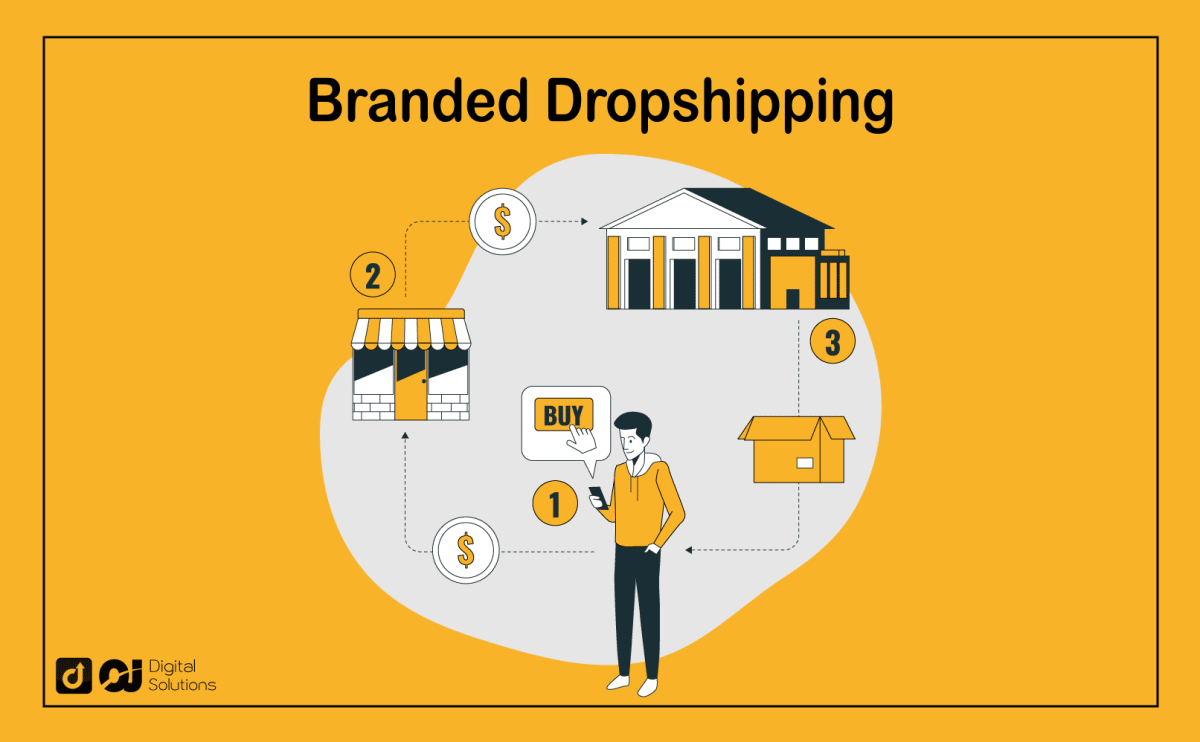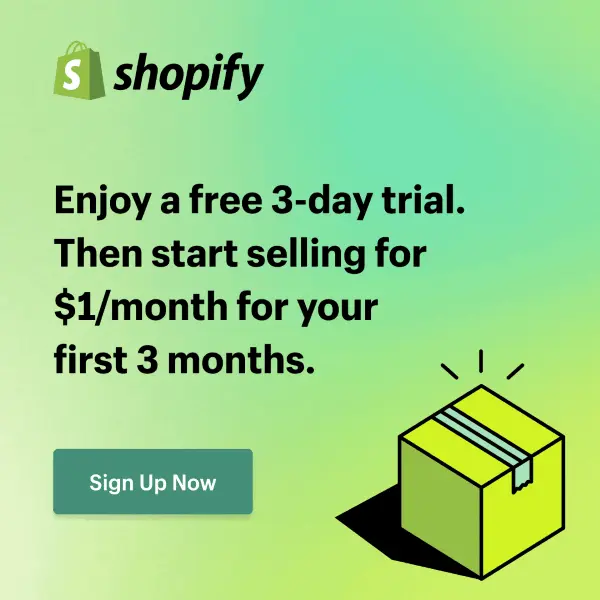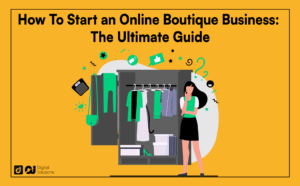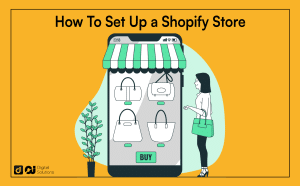Dropshipping businesses are some of today’s most popular startups.
However, this ecommerce business model can also have its drawbacks and challenges.
Since more and more online stores rely on the same supplier, they end up selling identical products—and this makes it hard to establish uniqueness.
But there’s a way to overcome this hurdle: dropshipping branded products!
The question is: what is branded dropshipping, and how do you do it?
In this article, I’ll answer all your questions about branded dropshipping and show you how to brand dropshipping products. So, let’s begin!
What is Branded Dropshipping?
What exactly is branded dropshipping?
Well, branded dropshipping is just like normal dropshipping.
However, instead of selling generic products from your supplier, your products are branded.
In this business model, you must have an agreement with your dropshipping supplier to print your logo or branding on your product or product packaging.
You can also go for print-on-demand dropshipping, where your branding gets integrated into the product’s design.
Here are some examples of branded dropshipping stores:


Branded Dropshipping vs Dropshipping: What’s the Difference?
Dropshipping branded products follows the typical dropshipping business model except for one significant factor: the dropshipped products’ brand.
With branded dropshipping, people see your unique identity, including your own dropshipping brand logo, brand values, product packaging, and more.
| Branded Dropshipping | Normal Dropshipping | |
|---|---|---|
| Costs less | ✔️ | |
| Takes time to set up | ✔️ | |
| Competitive advantage | ✔️ | |
| Potential for higher profit margins | ✔️ | |
| Better credibility | ✔️ | |
| Better customer experience | ✔️ | |
| Better brand growth | ✔️ |
What are the Pros and Cons of Branded Dropshipping?
A Unique Brand Lets You Stand Out.
There are about 100,000 dropshippers and 12 to 14 million online stores worldwide. With all that competition, standing out can be challenging.
One way to attract potential customers is to create your own brand name and sell your own branded products.
You can personalize your products. You dictate the designs, packaging, special selling features, and more. These characteristics make it easier for your brand name to stand out.
A Brand Creates Trust.
People might buy brands because they have a following, but they stay loyal to brands because of product quality and a sense of community.
Your branded dropshipping store can quickly build both and generate customer loyalty at the same time.
You have better control over product quality if you make a unique brand and sell your own custom products.
These advantages help cement a brand identity and create brand loyalty amongst potential customers.
A Brand Gives You Control.
You have less control when selling existing brands’ products on your online store.
If your private label supplier raises the prices, you must either pay or look for another reliable supplier.
Your online store could also suffer if the brand receives negative publicity.
A unique brand saves you from these headaches because you have control over such factors.
Here are some branded dropshipping pros and cons:
| ✅Pros | ❌Cons |
|---|---|
| Potential for higher profit margins | Building a strong brand takes time |
| Increased customer trust and loyalty | Higher MOQs (Minimum Order Quantity) |
| Easier to scale your business | Higher upfront investment |
| Distinguish your brand from competitors | Requires regular marketing efforts |
| Marketing advantages |
How to Create a Branded Dropshipping Store in 9 Simple Steps
Is branded dropshipping easy or hard to start? I’ll show you how to start your own dropshipping business in a few simple steps.
Step 1 – Identify Your Niche
By choosing a well-defined niche, you can tailor your product selection to align perfectly with your brand’s identity.
The right niche will also make it easier for you to highlight a unique selling proposition for your products.
However, finding your niche won’t be easy, so you must do your homework.
Carry out in-depth initial market research to find underserved niche markets with less competition and a higher sales potential.
Check other branded dropshipping stores, and look at their best-selling products.
Be on the lookout for social media platform hashtags that may be related to your potential niche.
Use in-depth market research tools to help you identify your target audience, as well as your customers’ needs and preferences.
Step 2 – Find Products to Sell
If you’re looking to dropship branded products and enjoy a steady stream of revenue, your branded dropshipping store should sell a “winning product”.
Ideally, such products must be unique, durable, profitable, and designed to solve a customer’s problem.
And of course, the product must also generate profits.
Make sure to choose one that lets you fulfill your brand promise and branding goals in a way that appeals to your customers.
To identify these winning products, a reliable product research tool can help you out.
| Product Research Tool | What is it? | Price | Try it now! |
|---|---|---|---|
| AliExpress Dropshipping Center | This tool helps you find profitable products on AliExpress to sell , as well as reliable white label suppliers for your goods. | Free | Try AliExpress Dropshipping Center here! |
| Thieve.co | Thieve.co gives you access to a catalog of best-selling products from any niche found on AliExpress. | Starts at $15 monthly | Try Thieve.co free for 14 days here! |
| SellTheTrend | SellTheTrend’s Product Explorer uses AI to help you analyze market trends and find profitable products from over 83 ecommerce niches. | Starts at $39.97 monthly | Try SellTheTrend free for 7 days here! |
| AutoDS Product Research Tool | AutoDS features a Winning Products Hub that helps you single out hot-selling products based on their ratings, reviews, sales numbers, target audience, and more! | Starts at $9.90 monthly | Try AutoDS for $1 here! |
| JungleScout Opportunity Finder | JungleScout’s Opportunity Finder helps you uncover profitable niches by showing you Amazon keywords with high demand and low competition. | Starts at $49 monthly | Try JungleScout with a 7-day money back guarantee here here! |
| Niche Scraper | Niche Scraper has a product research dropshipping bot that helps you find the best-selling products on Shopify and AliExpress. | Starts at $49.95 monthly | Try Niche Scraper free here! |
| Dropship.io | Use Dropship.io’s extensive database to spy on competitor’s revenue and see which of their products sell the most. | Starts at $29 monthly | Try Dropship.io free here! |
Step 3 – Pick a Store Name
Your branded dropshipping store’s name should create a positive and memorable impression on customers.
Make sure to pick one that helps establish your store’s identity, branding, and personality.
By doing so, there’s a higher chance for customers to search for your online store when they enter the market.
If you need help with creating a store name, you might want to try out these name generators:
Step 4 – Develop Your Brand Identity
Key Principles for Developing an Impactful Brand Identity
Brand recognition is crucial. What does your brand name stand for? What story do you want to tell?
Create an identity that clearly defines your brand appearance and message to target customers.
Developing a branding style guide will help you set parameters for your brand identity, overall look, theme, voice, personality, and more.
Here are some things to consider when it comes to creating your brand identity:
Use text fonts, color schemes, and language styles that will attract your target audience
Inform your target audience of your brand’s mission, vision, and story
Let consumers know of your brand’s values
Develop a brand voice that sounds friendly and trustworthy
To sum it all up, effective branding is a key factor if you want to connect with customers and increase their chances of returning to your branded dropshipping store for future purchases.
6 Ways to Showcase Your Brand Identity
After creating your brand identity, here are some ways to apply it to your products:
Website – You can use your ecommerce site as a storybook where you can set the vibe, address your audience, and exercise your distinct brand voice.
Color schemes – Consider what emotions you want your brand to evoke in customers. Then, use the right colors to enhance these emotions and create a recognizable brand image in their minds.
Labels – Customized labels differentiate your branded products from those sold by similar-branded dropshipping stores.
Logo – Choose from text-based or symbol logos. Just make sure to pick one that aligns with your brand image, highlights the character of your brand, and boosts the perceived quality of your products.
Branded packaging – Highlighting how your brand stands out through custom packaging differentiates your products from those of competitors. Also, your product’s packaging is the first thing customers come in contact with. Make your brand stand out with custom packaging that’s attractive, durable, and easy to open!
Some custom packaging types that are perfect for showcasing your brand identity are zipper bags, paper shopping bags, gift boxes, bubble envelopes, eyeglass cases, or shoe boxes.
Packaging inserts – Your branded packaging is already an effective marketing tool for your brand name, but packaging inserts work just like icing on the cake.
These inserts are perfect opportunities for cross-selling, social media engagement, getting feedback, or encouraging repeat sales.
7 Ways to Practice Dropshipping Branded Products with Print on Demand
Custom labels – A distinctive label lets customers distinguish your product apart from those of other brands.
Inside labels – These labels are typically printed under the collar inside of garments, particularly those with tear-away labels. The tag can also display information, such as size, fabric, care instructions, or country of origin.
Outside labels – These labels are usually used for T-shirts with no removable tear-away label, and are printed on the outside of the shirt under the collar.
Sleeve print – Sleeve print branding on T-shirts or long-sleeve tops is perfect for making your logo stand out. These product labels work as constant ads for wearers and the people around them.
Package inserts – Also called “pack-ins”, these inserts can be in the form of stickers, thank you cards, postcards, or discount coupons. These inserts help you build a relationship with your customer, making them remember your store the next time they want to shop online.
Step 5 – Find a Reliable Branded Dropshipping Supplier
Finding a trustworthy branded dropshipping supplier can be a real challenge, especially if you’re just about to start selling online.
But don’t worry, here’s a list to help you find dependable private label suppliers!
| Supplier | Primary Location | Pricing | Try it here! |
|---|---|---|---|
| AliExpress Dropshipping | China | Free | Try AliExpress here! |
| CJDropshipping | China | Free | Try CJDropshipping here! |
| Modalyst | US/EU | Free / $35 monthly ($360 yearly) / $90 monthly ($804 yearly) | Try Modalyst free here! |
| Dripshipper | US | $30 monthly / $99 monthly / $197 monthly | Try Dripshipper for 14 days free here! |
| SaleHoo | New Zealand | $27 monthly ($270 yearly) / $97 monthly ($970 yearly) | Try SaleHoo here! |
| Spocket | Canada | Free / $39.99 monthly / $59.99 ($288 yearly) / $99.99 monthly ($684 yearly) / $299 monthly ($948 yearly) | Try Spocket for 14 days free here! |
| Gelato (for print-on-demand products) | Norway | Free / $14.99 monthly ($139 yearly) / $99 monthly ($999 yearly) / Custom pricing (Platinum plan) | Try Gelato here! |
| Printful (for print-on-demand products) | US | Free to use, but you have to pay for products you sell, their fulfillment, and shipping costs after customers buy from you | Try Printful here! |
| SellTheTrend | Canada | $39.97 monthly ($395.64 yearly with two months free) / $99.97 monthly ($959.64 yearly with two months free) | Try SellTheTrend for 7 days free here! |
| AutoDS | Israel | Starts at $9.90 monthly (depends on which ecommerce platform you are selling) | Try AutoDS for $1 here! |
| Blanka | Canada | Free / $29 monthly ($312 yearly) / $59 monthly ($588 yearly) / $99 monthly (888 yearly) | Try Blank for 14 days free here! |
| Alibaba | China | Free | Try Alibaba here! |
| Wiio | China | Free | Try Wiio here! |
| HyperSKU | China | Free | Try HyperSKU here! |
Negotiate with Private Labeling Suppliers
Branded dropshipping suppliers will require an MOQ (minimum order quantity) whenever you purchase from them.
Depending on your product, private label suppliers can require 50, 100, 500, or 1,000 units per order.
But if you’re still in the process of choosing a branded dropshipping supplier and you wish to order a sample of their private label products, it won’t hurt to negotiate.
Let the private labeling supplier know that you’re planning to sell their product in your online store, and that you’d like to order just a few samples for testing.
It may come as a surprise, but most branded dropshipping suppliers are open to negotiations.
Also, try to order samples from different private label suppliers so you can compare the different products side by side.
This helps you find out which private label dropshipping supplier has the best packaging, shipping time, product quality, and dropshipping service.
Step 6 – Build Your Store
With a reliable branded dropshipping supplier in place, it’s now time to create your Ecommerce store!
Choose Your Hosting Plan
Your hosting provider is responsible for storing your website content and files online.
To get the best value for your money, I recommend going with Bluehost (starts at $2.95 monthly) or HostGator (starts at $2.75 monthly).
Select an Ecommerce Platform
An ecommerce platform allows you to create your online store, where your target market can find and purchase your products.
It also gives you tools for managing and automating your dropshipping service and business operations.
Such processes can include analytics, marketing, order processing, inventory management, or setting up payment gateways,
Some even integrate with most social media platforms, so you can incorporate your marketing efforts into your online store.
I would recommend creating a Shopify store if you’re not sure which ecommerce platform works best for your branded dropshipping business.
Shopify’s user-friendly interface makes it easy for you to create a professional-looking website from start to finish, even without technical know-how or advanced coding skills.
Through this platform, you can fully customize your store’s layout and design in a way that aligns with your brand identity.
Shopify has over 6000 apps that can help you automate your dropshipping business operations and integrate your branded store into marketplaces, such as Amazon, Etsy, or eBay.
If you need more help picking out an ecommerce platform, check out this article for my in-depth review of the best ecommerce platforms for small businesses.
Step 7 – Create and Optimize Your Product Listings
Now’s the time to start adding products to your ecommerce website!
For each product, create an engaging landing page with keyword-rich and compelling product descriptions, high-quality lifestyle images or videos, or even product testimonials.
Make sure that the product descriptions highlight more of the product’s benefits. Fill them with keywords that shoppers use when searching online for products like yours.
It’s also a good idea to include information about payment options, return conditions, shipping times, and delivery options.
Step 8 – Promote Your Online Store with Paid Ads
After setting up your branded dropshipping store, you now have to promote it so that it attracts customers and potential shoppers.
First, identify the specific target audience you wish to engage through your ad campaigns and marketing strategies.
If you’re selling baby supplies and accessories, your target market can be daycare providers, newly married couples, or expecting parents.
Choose ad traffic sources (I recommend having at least two ad traffic sources) where you can get the word out and drive shoppers to your online store.
Some platforms where you can run your paid ads are Facebook, YouTube, Google, TikTok, or Pinterest. You can also consider creating social media accounts, writing blogs, or partnering up with social media micro-influencers.
But most importantly for brand owners and online retailers like you, the best way to get loyal customers and retain them is by selling your own products that offer great value for money.
If people see more value in your product than the money they are giving up in exchange for it, they will surely make that purchase.
Step 9 – Start Fulfilling Orders
Now that your store is up and running, you should also be ready to fulfill your customers’ orders in a timely manner.
This includes receiving and verifying the order, managing inventory, packing the product, tracking the shipment, and addressing customer support requests, among others.
There are three ways to fulfill orders:
Manual fulfillment – In this setup, you have to forward the customer’s details to the supplier on your own whenever you receive an order.
Automated fulfillment – Some ecommerce platforms automate the whole order fulfillment process. This means that once a customer places an order, the white label supplier receives the information right away and they prepare the order.
Third-party apps – Even if you process orders manually, you can outsource this through paid third-party fulfillment apps, such as AutoDS. This software helps with order and inventory management, and updates your listings if there are changes in pricing or stock levels.
Branded Dropshipping FAQs
What is branded dropshipping?
Branded dropshipping works just like traditional dropshipping. However, the products you sell have your own logo and brand identity.
With dropshipping, you won’t have to deal with labeling, packaging, and shipping products to your customers.
Is it legal to dropship branded products?
Yes, it’s perfectly legal!
However, just make sure not to infringe on copyrights or sell products that are forbidden, and always follow online business regulations in your country.
How do I get branded dropshipping?
Start by choosing a profitable niche and finding winning products to sell. Build your online store, find a white label supplier that delivers excellent dropshipping services, and market your ecommerce site. You can fulfill orders on your own or use paid tools to automate this process.
The Bottom Line
Is dropshipping name brand products a profit-generating online business model? Branded dropshipping is an excellent way to start selling, especially if you are looking to create your own brand name.
I hope my guide helped answer the question: “What is branded dropshipping?”. Now you can decide whether or not to dropship your own brand, and find out if selling products online is rewarding.
Don’t be afraid to try dropshipping, especially if you have an excellent idea for a branded product!







